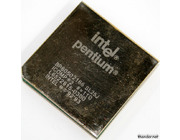Intel Pentium 166
First of all: this CPU is fake!
Some people take lower-end CPU's, modify (overclock) them to look like a faster model and sell them. This practice has been around for years and has been done quite recently as well. You can find fake 386 and 486 as well which often have something taped over that says it's a faster model. For example a 50MHz CPU is sold as 66MHz.
These gold CPU's are a bit different, though. They didn't modify the (ceramic) CPU but took a mobile CPU and build a gold (but actually good looking) cover around it. Everything is made very well and the CPU works well, too.
Modern examples of fake CPU's are the AMD Athlon XP. These CPU's don't have a CPU string so the name of the CPU (which you see in Windows or CPU-z) is generated by the BIOS. If you take a 2500+, tape over the OPN code so it will show 3200+, then people will configure it as a 3200+ (which has a faster FSB but the same multiplier) and the BIOS will show AMD Athlon XP 3200+. There you go: you made more than a 100$ profit.
How to recognize these fake CPU's? In this case it's pretty obvious because of the gold packaging. Sometimes it's difficult but look carefully. Often the font is a bit different or the position of the words doesn't match. Also check the OPN or sSpec code. Take a look at the SL25J sSpec code on this CPU which is from a Pentium 120! In some cases the production date doesn't appear to be valid; fakers seem to generate a random number but when you're into these number you can read the production date. Some CPU's are made after week 52/53 from a particular year which is not possible.
If you ever find one of these CPU's and want to open it (like I did) be careful! You can pop open the top with a screwdriver but be careful when cleaning the 'die' (core; the chip in the middle). It has very tiny connections/lines and if you move them they can break or short as soon as you power up the CPU.
 6x86 P166+
6x86 P166+


